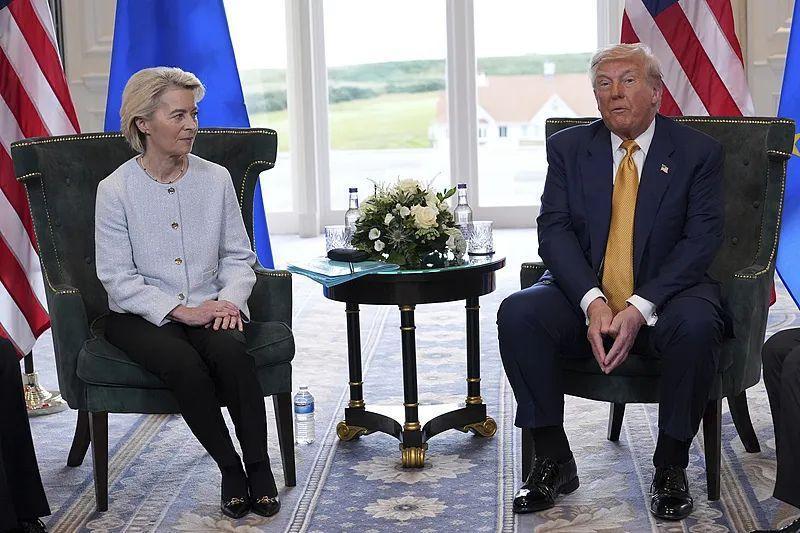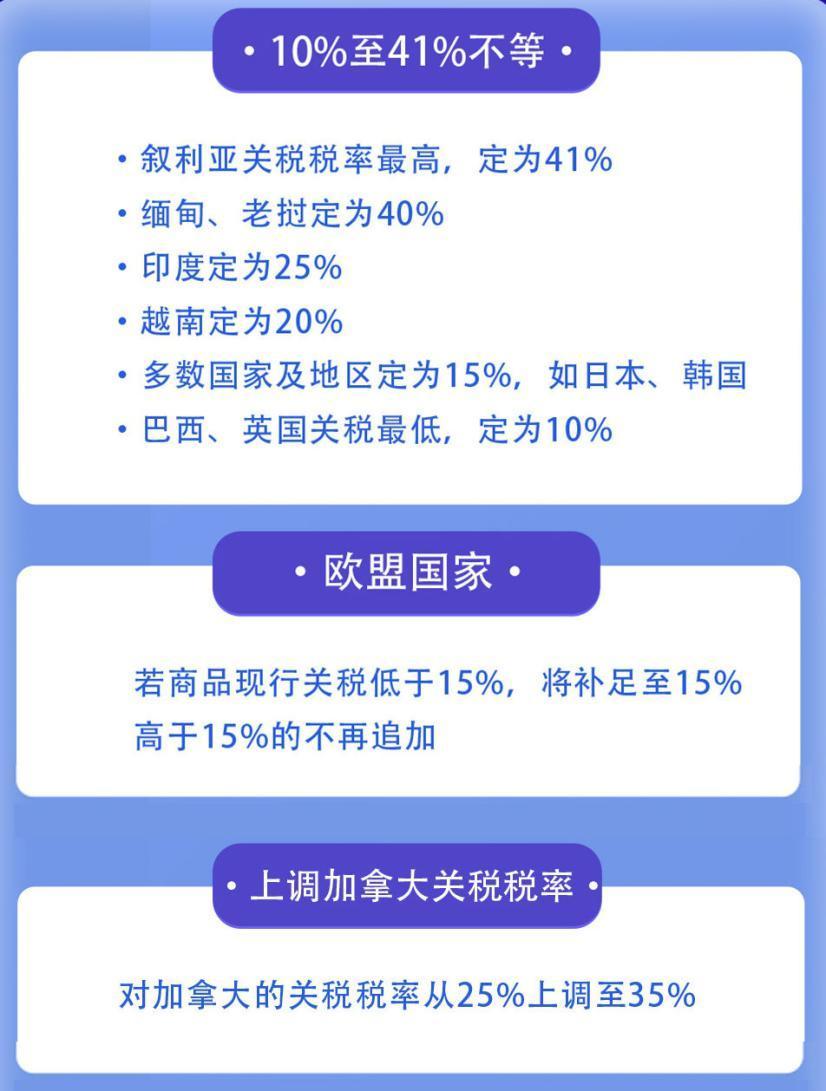
The White House has announced an adjusted "equivalent tariff" rate schedule, which will take effect on August 7.
In the new tax rate, the tax rate of countries with a trade deficit in goods with the United States is 10%; countries that have agreements with the United States or have a small-scale commodity trade surplus with the United States have a tax rate of about 15%; Countries that have no agreement with the United States and have a large merchandise trade surplus with the United States face higher tariffs, including the United States raising tariff rates on Canada from 25% to 35%, Switzerland and South Africa facing punitive tariffs of up to 39% and 30% respectively, and India being subject to 25% tariffs.

Copper prices in New York plummeted 17.7% in one day
Trump signed an executive order announcing that starting August 1, a high tariff of 50% will be imposed on imported semi-finished copper and copper-intensive products. As soon as the news came out, the global market "fryer", and copper prices directly "dived", recording the most tragic single-day decline in history.
Let's break it down and what this means.
Why did copper prices plummet? In a word: demand expectations have collapsed. On the same day, copper futures prices on the New York Mercantile Exchange (COMEX) plummeted 17.7%, marking the largest one-day drop in history.
Why did it fall so hard? Because the market originally expected that the recovery of global manufacturing would drive a rebound in copper demand, especially in new energy, power grids, electric vehicles and other fields. However, this paper tariff order directly breaks this logic: the United States wants to restrict the import of a large number of copper products, which means that the demand for the global copper industry chain will be seriously weakened; The market is worried that other countries may follow up or counteract, triggering an escalation of trade frictions; Investors panic selled, causing prices to fall in a "stampede".
What is the scope of the tariffs? This tax increase is not a small fight, and the scope is very wide. Products directly taxed include: semi-finished copper: such as copper pipes, copper wires, copper rods, copper plates; Copper-intensive derivatives: such as cables, connectors, pipe fittings, electrical components, etc. In the future, the scope may be expanded to include more copper products. It is based on Section 232 of the Trade Expansion Act of 1962 - that is, for "national security" reasons, and the same routine as the tax increase on steel and aluminum that year.
However, the White House also added that it will not be superimposed with car import tariffs. If the product is an auto part, only automobile tariffs apply; Avoiding double taxation is a way to leave a gap.
Does the United States still want to "lock" local copper resources? In addition to the import tax increase, the White House also proposed that 25% of high-quality copper scrap and raw copper products must be sold in the United States and cannot be exported. It sounds "protectionist", but the reality is that about 40% of US copper scrap and 75% of copper concentrate are already processed locally; Therefore, this export restriction has a limited impact in the short term, and it is more of a political signal.
Who was injured? Who benefits? This policy of "hurting the enemy a thousand and losing eight hundred" has far-reaching effects:
Injured:
Global copper industry chain enterprises: especially copper processing, cable, and electronic component manufacturers that rely on the US market; Copper exporters: such as Chile, Peru, Congo (DRC), etc.; International commodity traders: Trade flows will be forced to restructure.
Possible Benefits:
Local copper smelting and processing companies in the United States: protected in the short term, market share may increase; Alternative material suppliers: such as aluminum, optical fiber, etc., may be used to replace copper in some fields. But beware: U.S. manufacturing may face rising costs. Cables and connectors are the "blood" of the industry, and when the cost rises, the price of electric vehicles, home appliances, and infrastructure will all increase.
Many countries are dissatisfied and have spoken out one after another
Canada said to the United States: "No, it's not fair!
Doug Ford, Governor of Ontario, Canada, publicly stated: "Canada should not accept anything that is not right." This sentence sounds a bit "philosophical", but it is actually shouting to the United States: We do not recognize the tariffs you have added, and we are not afraid!
The United States recently announced tariffs on imported steel and aluminum products, citing the familiar "national security". Although Canada is a neighbor and ally, it has not been spared, and this move has directly hit Canada's "industrial lifeline" - the steel and aluminum industry is an important pillar of Canada's manufacturing industry.
Therefore, Governor Ford was angry: "We must fight back!" It is recommended to impose a 50% retaliatory tariff on U.S. steel and aluminum! "This is not an emotional vent, but a clear signal of countermeasures.
Not only local officials have spoken, but Canadian Prime Minister Carney has also made it clear: in trade negotiations with the United States, the Canadian government has always firmly defended its own interests; The goal is clear: to fight for the most beneficial trade deal for Canada; At the same time, the government is taking all possible measures to support industries affected by tariffs. From the local to the central, Canada is "united as one" this time, ready to be tough to the end.
Brazil: Retaliatory tariffs on some U.S. products will be considered
According to the latest news: From August 6, the United States will impose a 40% tariff on most Brazilian products exported to the United States. While some goods such as aircraft, nuts, orange juice and some metal products are exempted, a large number of other products still face high tariffs of 50%.
Summary in one sentence: Brazil's exports to the United States are going to "increase in price".

In the face of US tariff measures, Brazil is not weak.
President Lula said: Consider retaliatory tariffs. If the United States does impose tariffs, the Brazilian government will consider imposing retaliatory tariffs on some American products. This is a very clear signal: if you raise taxes, I will counteract.
Program and Budget Minister Simone Tebet criticized U.S. unilateralism, and Brazilian Program and Budget Minister Simone Tebet also spoke out: criticizing the United States for promoting unilateralism and trade protectionism, and stressing that Brazil will not compromise on strategic choices. This sentence translates to: we have our own bottom line and will not give in casually.
It seems to "win the tariff", but in fact it "hurts a thousand"
The United States has frequently taken action on trade policy, imposing high tariffs on many countries, ostensibly to "defend its own industry", but the latest data reveals a worrying trend: the United States may be turning itself into an "island" in the global economy.
Investments are almost "standing still": the US economy is yellow.
The latest data shows that in the second quarter of 2025, the growth rate of US investment will be only 0.1%; This growth rate is approaching the "tipping point of economic recession"; If this week's GDP data also confirms this trend, it will be a clear economic warning signal. If the money is not invested, the enterprise does not expand production, and economic growth is about to "stall".
The backlash of tariffs: protectionism is "hurting itself". Many people think that the tariffs are imposed to "protect domestic industries", but the reality is that tariffs artificially raise production costs, which weakens the competitiveness and investment attractiveness of the United States.
How much does it cost? The global loss is $2 trillion. More seriously, the cost of this tariff war is not only for the United States, but also global. It is predicted that by the end of Trump's term in 2028, the cumulative loss of global GDP could be as high as $2 trillion.
Who pays? Consumers: rising prices; Enterprises: Profits shrink; Emerging markets: Exports are frustrated, development is hindered. There are no winners, only prices.





